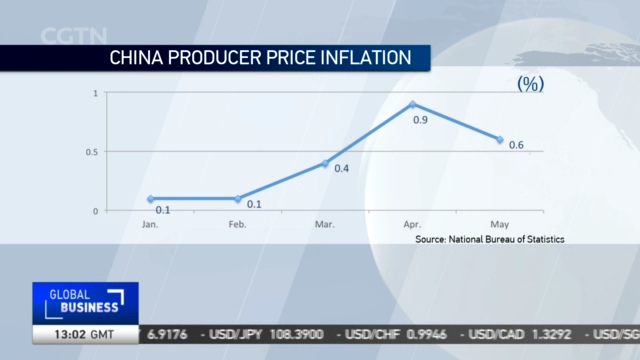
23:13, 12-Jun-2019
China's Inflation: China's factory inflation slows as production eases but food prices surge
Updated
17:32, 09-Jul-2019

China's inflation data showed a spike in consumer prices - CPI jumped by the most in over a year. While factory gate inflation eased. Xia Cheng drills down on the numbers.
Slower factory gate inflation in China thanks to sluggish commodity demand and weak manufacturing activity.
The gauge for industrial demand eased in May from a four-month high in April, bringing back growth concerns.
Consumer prices, however, soared at their fastest pace in over a year.
That's driven by elevated prices of pork and fruit due to supply issues stemming from the outbreak of African swine fever and poor weather conditions.
CAI JIN, CHAIRMAN CHINA FEDERATION OF LOGISTICS AND PURCHASING "Fruit prices are seasonal, and we are seeing a lot of fruits coming to the market after May, calming their prices."
But the whole year consumer inflation for 2019 is not likely to rise further.
ZHANG LIQUN, RESEARCHER DEVELOPMENT RESEARCH CENTER OF THE STATE COUNCIL "For the rest of the year, there are base effect to be considered, so inflation will stay below 3%."
As the China-US trade war intensifies, there are worries about a global recession.
Not helping lift sentiment, China's May exports unexpectedly returned to modest growth but imports fell at the sharpest rate in three years.
The slowdown in Producer Price Inflation was in line with downbeat factory activity seen in May.
The main drags are weak price gains in oil and natural gas extraction, coal processing and ferrous metals.
Despite China's effort to spend big in infrastructure projects, sluggish demand has dampened the prices of construction materials, especially steel and copper prices.
Xia Cheng, CGTN, BEIJING.
SITEMAP
Copyright © 2018 CGTN. Beijing ICP prepared NO.16065310-3
Copyright © 2018 CGTN. Beijing ICP prepared NO.16065310-3